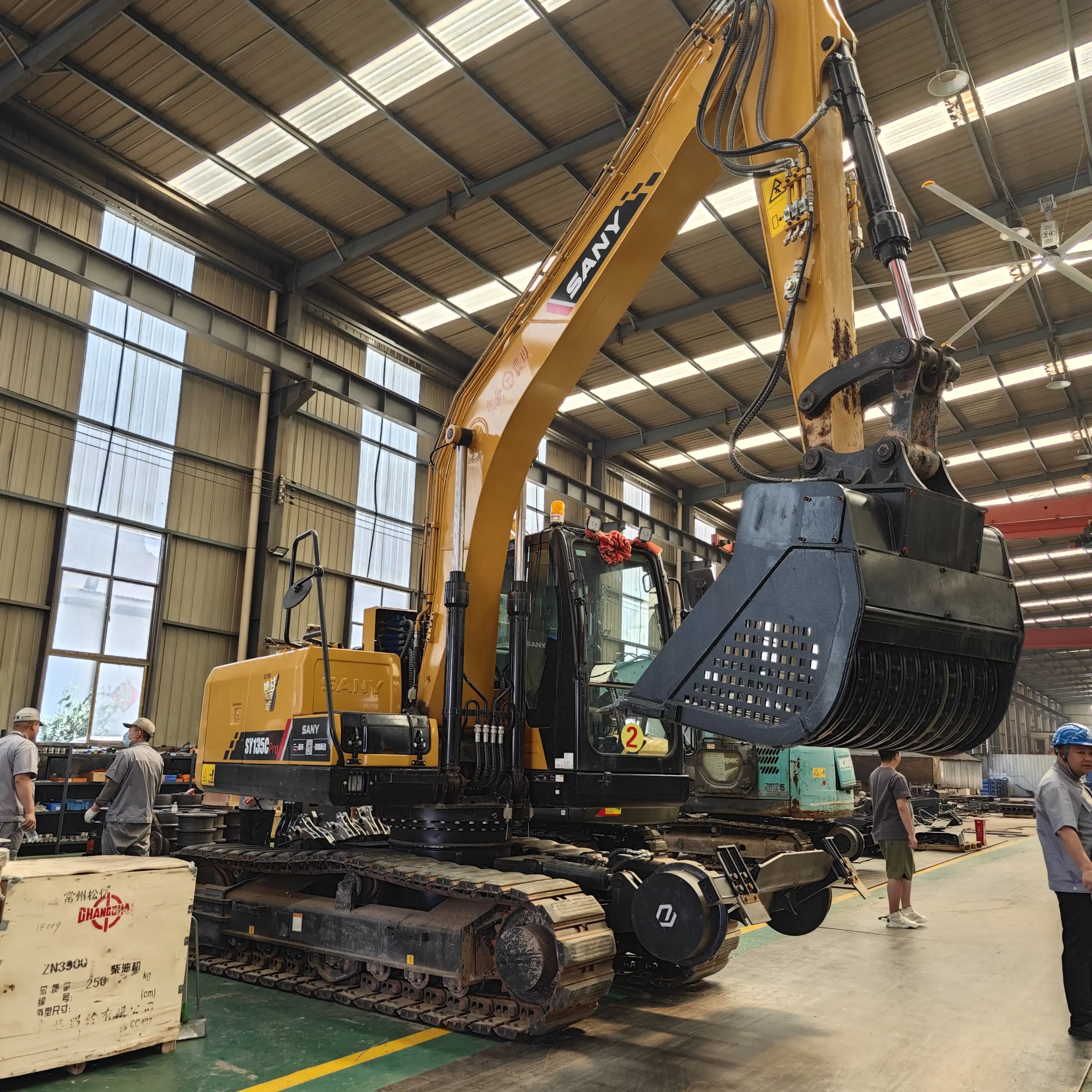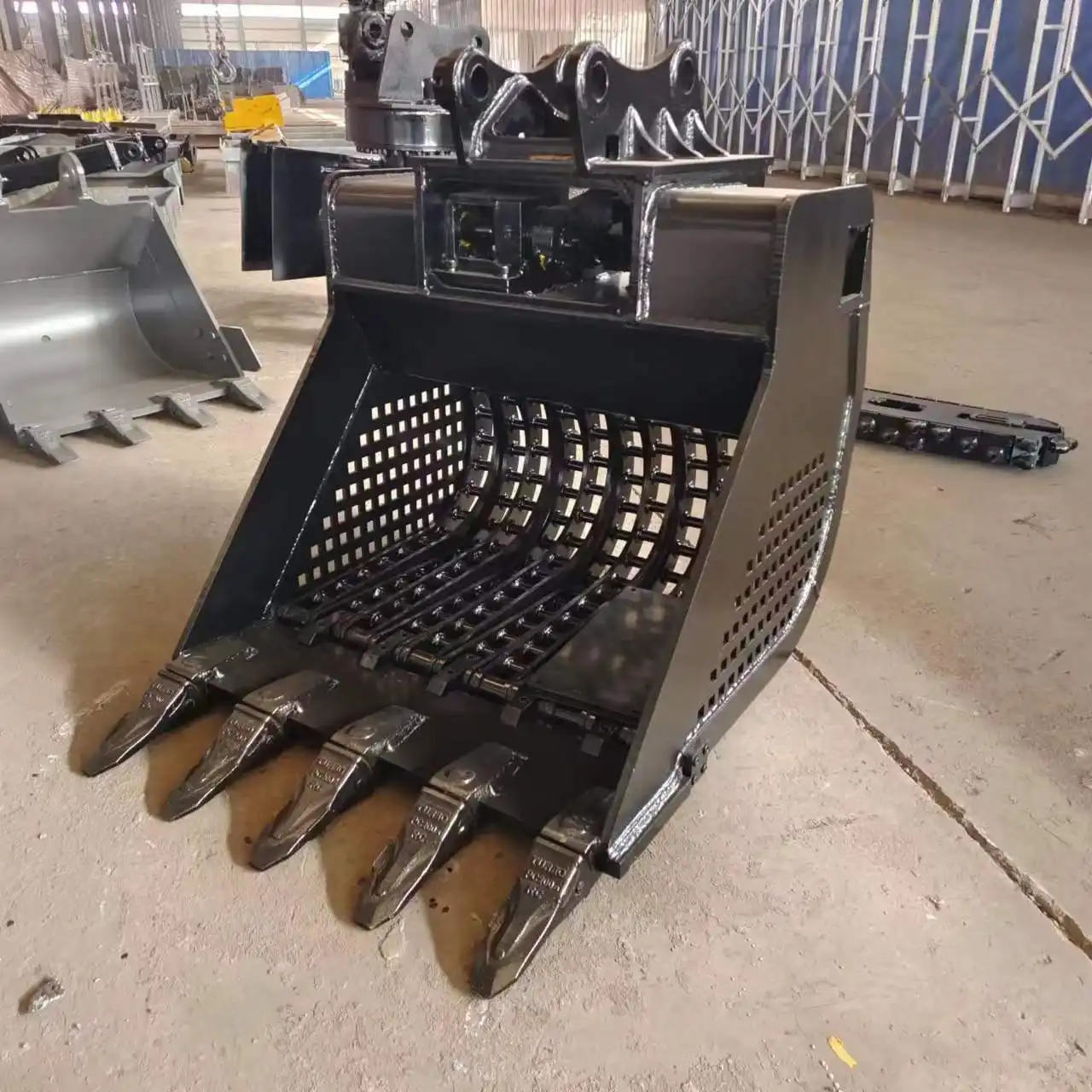Rotary Screening Bucket VS High Frequency Vibrating Screening Bucket
When tackling material separation challenges in construction, demolition, or excavation projects, selecting the right excavator screening bucket can significantly impact your operational efficiency and project outcomes. The market offers two primary contenders: rotary screening buckets and high-frequency vibrating screening buckets. Both serve the essential function of separating materials, but they employ distinctly different mechanisms that make each ideal for specific applications.
Rotary screening buckets excel in handling mixed materials containing larger fragments, making them perfect for construction waste processing and primary screening operations. Their robust design allows them to withstand harsh conditions while effectively separating materials through a rotating drum mechanism. Conversely, high-frequency vibrating screening buckets shine when precise material classification is required, with their rapid vibration system efficiently separating uniform particles for applications like aggregate processing.
Screening Mechanism

The screening mechanism represents the core functional difference between these two bucket types, dictating their suitability for various applications and materials.
Rotary Screening Bucket: Physical Rotation for Effective Separation
Rotary screening buckets operate on a straightforward yet effective principle. The bucket contains a cylindrical drum that rotates along its horizontal axis. When material enters the bucket, the rotation causes the material to tumble inside the drum. Smaller particles pass through the predetermined screen openings, while larger pieces remain within the drum for separate discharge.
This mechanism makes rotary excavator screening buckets particularly adept at handling:
- Construction and demolition waste containing mixed materials
- River sediment with stones and organic matter
- Excavated soil with rocks and debris
- Compost processing where separation of larger uncomposted materials is necessary
The physical screening action creates less compaction of materials, allowing for better processing of materials that might contain moisture or clay content. Additionally, the continuous rotation can help break apart clumped materials, improving the overall screening efficiency.
High-Frequency Vibrating Screening Bucket: Precision Through Vibration
Unlike their rotary counterparts, high-frequency vibrating screening buckets employ rapid oscillation to separate materials. The bucket features a vibrating mechanism that creates thousands of micro-movements per minute, effectively "shaking" smaller particles through the screen mesh while larger materials remain above.
This high-frequency vibration mechanism excels when working with:
- Sand and gravel processing requiring precise gradation
- Mining aggregates that need consistent sizing
- Topsoil screening for landscaping projects
- Fine material recovery operations
The vibration-based approach typically achieves higher throughput rates for fine materials and produces more consistent sizing in the screened output. The absence of rotating components also means there's less material tumbling, which can be beneficial when processing more delicate materials or when aiming to minimize material degradation during processing.
Material-Specific Performance Considerations
When evaluating which excavator screening bucket mechanism better suits your needs, consider:
- Material moisture content: Rotary buckets often handle wet materials better, while vibrating screens may experience clogging with highly moist materials
- Desired throughput: High-frequency vibrating screens typically offer faster processing of fine materials
- Material fragility: Vibrating screens generally cause less material breakdown during the screening process
- Screen mesh size requirements: Vibrating screens typically accommodate finer mesh options for more precise material classification
The screening mechanism fundamentally determines which materials you can efficiently process, making this understanding crucial for proper equipment selection. Your specific material characteristics should heavily influence which mechanism will deliver optimal performance for your application.
Hydraulic System Configuration

The hydraulic system requirements represent another critical differentiating factor between rotary and high-frequency vibrating excavator screening buckets. These requirements directly impact which excavator models can effectively power each bucket type and influence overall operational efficiency.
Rotary Screening Bucket: Continuous Power for Constant Rotation
Rotary screening buckets typically feature a hydraulic motor system that transforms hydraulic fluid flow into continuous rotational motion. This configuration presents specific operational requirements:
- Higher hydraulic fluid flow requirements (typically 60-120 liters per minute)
- Moderate pressure requirements (usually 180-220 bar)
- Continuous operation drawing consistent power
- Often includes pressure relief valves to protect against material jams
The hydraulic motor in rotary systems provides consistent torque output, allowing these buckets to power through challenging materials. However, this design necessitates excavators with adequate hydraulic flow capacity. When the excavator's hydraulic system cannot deliver sufficient flow, rotation speed decreases, adversely affecting screening efficiency.
Equipment compatibility considerations for rotary systems include:
- Auxiliary hydraulic circuit capability
- Flow rate capacity matching bucket requirements
- Hydraulic cooling capacity for extended operation
- Return line pressure handling
High-Frequency Vibrating Screening Bucket: Pressure-Intensive Operation
High-frequency vibrating screening buckets operate using either eccentric shaft mechanisms or dedicated vibration hydraulic cylinders. These systems convert hydraulic pressure into rapid oscillatory motion, creating the necessary vibration for material separation.
Key hydraulic system characteristics include:
- Moderate to high flow requirements (typically 40-100 liters per minute)
- Higher pressure requirements (often 220-280 bar)
- Pulsed operation creating varying load on the hydraulic system
- May incorporate accumulators to maintain consistent vibration frequency
Vibrating systems typically require excavators with robust hydraulic pressure capabilities. The pulsating nature of these systems can place different stresses on the excavator's hydraulic components compared to the constant load of rotary systems.
Equipment compatibility factors for vibrating systems include:
- Maximum hydraulic pressure capability
- Hydraulic component durability under pulsating loads
- System responsiveness to varying pressure demands
- Hydraulic line sizing and configuration
Hydraulic Integration and Operational Considerations
When evaluating an excavator screening bucket purchase, consider these hydraulic integration factors:
- Carrier equipment specifications versus bucket requirements
- Auxiliary hydraulic circuit configuration options
- Need for additional hydraulic components (flow dividers, pressure regulators)
- Impact on fuel consumption due to hydraulic power demands
- Temperature management during extended operation
Proper hydraulic matching ensures optimal performance and prevents premature component wear on both the bucket and carrier equipment. Many manufacturers offer adaptable hydraulic configurations to accommodate various excavator models, though this flexibility may come with performance compromises compared to ideally matched systems.
Understanding these hydraulic requirements helps ensure that your investment in an excavator screening bucket will function properly with your existing equipment fleet or guide additional equipment acquisition decisions to create compatible working systems.
Purchase Decision

Making an informed purchase decision requires careful evaluation of your specific operational requirements, material characteristics, and equipment compatibility. This systematic approach will help you select the optimal excavator screening bucket for your unique application.
Step 1: Determine Whether Hydraulic Drive is Required
Before choosing between bucket types, first determine if hydraulic operation is necessary for your application:
- Mobile screening requirements: If your operation requires on-site material processing in various locations, hydraulic screening buckets provide the mobility and flexibility needed.
- Production volume considerations: Hydraulic screening buckets generally offer higher production rates than static screens for on-site processing.
- Budget evaluation: Hydraulic screening buckets represent a significant investment, but can provide substantial returns by eliminating the need for material transport to central processing facilities.
- Operational versatility: Consider whether the ability to screen materials directly at the excavation or demolition site would significantly improve your workflow efficiency.
When mobility and on-site processing capability are priorities and your budget accommodates the investment, hydraulic screening buckets typically offer the best solution. The reduction in material handling and transportation costs often justifies the initial equipment expenditure.
Step 2: Select Sub-Categories Based on Material Characteristics
Once you've determined that a hydraulic excavator screening bucket is appropriate, analyze your material characteristics to choose between rotary and high-frequency vibrating types:
For materials containing large impurities, consider rotary screening buckets:
- River dredging operations with mixed sediment sizes
- Construction site cleanup with concrete, wood, and soil mixtures
- Land clearing with root systems and organic matter
- Primary screening of excavated materials before further processing
For applications requiring fine classification, consider high-frequency vibrating screening buckets:
- Mining aggregate processing requiring precise sizing
- Sand and gravel operations for construction materials
- Topsoil preparation for landscaping applications
- Recycling operations requiring material separation by size
- Final screening stages in material processing workflows
The material composition, especially the size range of particles and presence of oversized debris, should heavily influence your selection between these excavator screening bucket types.
Step 3: Verify Hydraulic Compatibility
Before finalizing your purchase decision, confirm that your carrier equipment can properly support the hydraulic requirements of your chosen screening bucket:
- Flow rate verification: Ensure your excavator can deliver the minimum hydraulic flow rate required by the screening bucket (measured in liters per minute).
- Pressure capability: Confirm your hydraulic system can maintain the pressure levels (measured in bar) required for optimal bucket operation.
- Auxiliary circuit configuration: Verify that your excavator has the appropriate auxiliary hydraulic circuits with the necessary couplings and control systems.
- Heat dissipation capacity: Evaluate whether your hydraulic system can manage the heat generated during continuous screening operations.
If your current equipment lacks the necessary hydraulic capabilities, explore adapter solutions or consider whether equipment upgrades might be justified by the productivity improvements the screening bucket would provide.
FAQ:
①What is the average lifespan of an excavator screening bucket?
With proper maintenance, quality excavator screening buckets typically last 5-7 years in regular use. Factors affecting longevity include material abrasiveness, maintenance practices, and operating conditions. Regular inspection of wear components and timely replacement of screens and bearings can significantly extend service life.
②How often do screening mesh elements need replacement?
Replacement intervals vary based on material abrasiveness and volume processed. In typical construction applications, screens may last 3-12 months before requiring replacement. Rotary bucket screens often have longer service intervals than vibrating screens due to the difference in movement patterns and resulting wear patterns.
③What maintenance is required for screening buckets?
Regular maintenance includes daily inspection of screens for damage, weekly greasing of moving parts, monthly inspection of hydraulic components, and quarterly comprehensive inspection of structural elements. Proper maintenance significantly impacts operational efficiency and equipment longevity.
Professional Guidance
Selecting between rotary and high-frequency vibrating screening buckets requires careful consideration of your specific operational requirements, material characteristics, and equipment compatibility. Both systems offer distinct advantages depending on your application context.
Rotary screening buckets excel in versatility and handling mixed materials with larger components, making them ideal for construction waste processing, river dredging, and primary screening operations. Their robust design and ability to process moist materials make them popular in challenging environments.
High-frequency vibrating screening buckets deliver superior performance for precise material classification, offering higher throughput rates for applications requiring consistent sizing like aggregate processing, sand and gravel operations, and final-stage screening workflows.
The optimal choice ultimately depends on aligning bucket capabilities with your specific material processing requirements and ensuring compatibility with your existing equipment. By understanding these key differences and following the outlined decision process, you can make a confident investment decision that enhances your operational efficiency.
For professional guidance in selecting the right screening bucket for your specific application, contact our team of experts at raymiao@stnd-machinery.com. With customizable options featuring bucket capacities from 0.3 to 3.0 m³ and adaptable grid spacing, Tiannuo's excavator screening buckets can be tailored to meet your exact operational requirements.
References
Construction Equipment Guide (2024). "Comparative Analysis of Screening Bucket Technologies in Modern Construction Applications."
Journal of Mining and Material Processing (2023). "Performance Evaluation of Rotary and Vibration Screening Systems in Aggregate Production."
International Construction Equipment Review (2024). "Hydraulic System Requirements for Excavator Attachments: A Comprehensive Guide."
Construction Technology Today (2023). "Material Processing Efficiency: Comparative Studies of Screening Bucket Types."
Heavy Equipment Engineering Review (2024). "Optimizing Excavator Attachment Selection for Specialized Material Handling Applications."
About Author: Arm
Arm is a leading expert in the field of specialized construction and railway maintenance equipment, working at Tiannuo Company.

